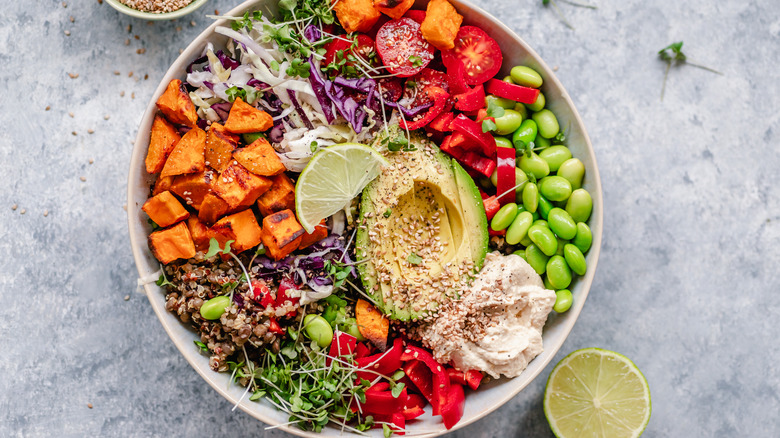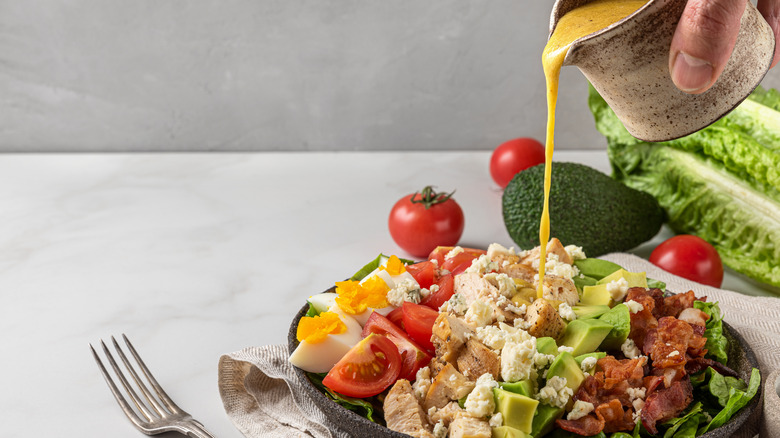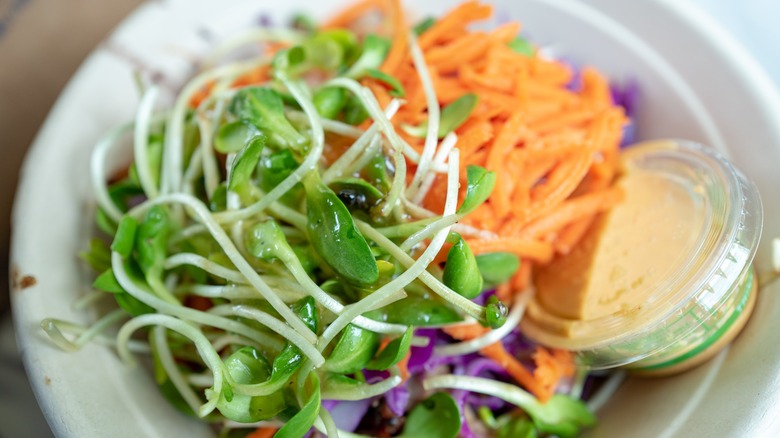The Simple Dressing Fix To Prevent Dreaded Soggy Salad Leftovers
It's not your imagination — it's easy to eat salad when it's already made for you. It's a lot of work to drag out the cutting board and the salad spinner to get a super-fresh bowl of greens and veggies. This is why bagged salad takes up half the lettuce section of the produce department — when you lower the friction, you're a lot more likely to get more salad in your diet. The problem with fresh salads made with tender lettuces is that they don't stay fresh and crunchy very long once you put the salad dressing on. There's no secret to keeping a big batch of fresh in crunchy salad in shape once you put the dressing on — the trick is to only dress what you'll eat in one sitting and then stash the rest, undressed, for later.
When delicate salad greens are exposed to salad dressing, their porous surfaces absorb the elements in the dressing and start to break down the cell walls. Think of salad dressing as something you put on last, like a hat and gloves before you leave the house. You can make a big batch of salad to have for meal prep all week or to take home after you have dinner at a restaurant.
Salad dressing breaks down lettuce greens
When salad dressing comes into contact with tender lettuce, the acids in the vinegar or citrus juice in the dressing start to break down the cell walls. A dressed salad has about an hour or two before the leaves start to look translucent and soggy.
Salad dressing is a lot like marinade in that it adds flavor by seeping into the cells and tenderizing whatever it's touching (and actually, vinaigrette salad dressings make good marinades). Some greens, including kale, can stand up to vinaigrette and get better over time. But tender baby greens, butter lettuce, iceberg, and other traditional greens don't hold up for very long.
When you're making a salad at home, it's easy to make more than you need for one meal. This is a good thing, especially if you're planning to pack up some salad for more meals later in the week. Most people don't have time to wash, cut, and pack a salad from start to finish. And even if you do, it's just faster to prep one big salad and portion it out than it is to get each individual ingredient out and chop a few pieces every day. When it comes time to serve the big salad, however, instead of tossing the entire thing with salad dressing, only toss what will actually get eaten and save the rest, undressed, for another day.
Order dressing on the side
An average salad portion is about two to three ounces per person, which is about a cup to a cup and a half — roughly one good-sized handful. Count the number of people at the dinner table, measure out a healthy handful for each person, and toss it in a big bowl with a tablespoon or two of dressing for each portion. If you run out of dressed salad, keep your dressing bowl handy, and you can dress a little more by request. Save the rest of the undressed salad for later.
If you're out at a restaurant or ordering takeout, where portion sizes can be big, ask for the dressing on the side so that you can take some of your uneaten salad home with you. Unless you're ordering something like a warm spinach salad, where the dressing is part of the dish's construction, it's just as easy to pour salad dressing on your plate yourself. When the bowl gets to the table, only dress what you're going to eat, and take the rest home.
Salad greens are some of the most frequently wasted foods around the world, according to NPR, and a huge contributor to the problem of food waste, especially at restaurants when salads are fully dressed. By ordering your dressing on the side, you'll be killing two birds with one stone — saving yourself the work of making a salad for your next meal and keeping food out of the landfill.


